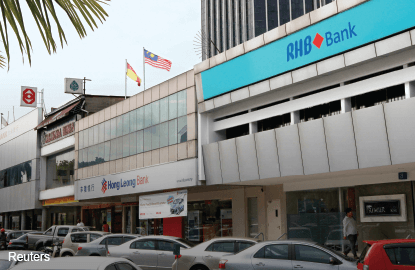
This article first appeared in The Edge Malaysia Weekly, on March 7 - 13, 2016.
A common thread runs through the financial results of banks for the quarter ended Dec 31, 2015 — higher provisions for impaired loans. Provisions doubled at most banks and increased significantly at some of them.
This was one of the reasons for the underwhelming net profits posted by the banking sector this year.
Public Bank Bhd was the only entity to report a write-back of provisions for loans in 4Q2015 and lower provisions for impaired loans for its financial year ended Dec 31, 2015 (FY2015). Its net profit for FY2015 rose 12% year on year to RM5.06 billion.
A close look at the provisions shows that while banks have been providing for impaired loans at a rapid pace, bad debt recovery has been slow — not quite a positive sign.
Affin Holdings Bhd, which benefited from the recovery of a massive amount of bad debt — RM141.9 million — in FY2014 ended Dec 31, saw recovery falling to RM84.52 million in FY2015 while provisions doubled during the period.
Higher provisions are usually perceived as an indication that banks see the possibility of a bigger default rate. “Well, that is one way of looking at it. But if loans have been over-provided for, they can be written back in the future,” says an analyst.
In the fourth quarter ended Dec 31, 2015, RHB Capital Bhd’s net profit declined 35% to RM316.12 million while its annual net profit dropped 26% to RM1.51 billion. The bank says profits were affected by expenses of RM308.8 million for its Career Transition Scheme. It also highlights that its performance was affected by higher loan impairment charges and the absence of large write-backs.
Hong Leong Bank Bhd’s profit for the cumulative period of six months ended Dec 31, 2015, fell 23% from a year ago to RM847.04 million while Affin Holdings’ net profit for FY2015 declined to RM369.27 million from RM592.68 million previously. Both banks cited higher loan provisions for the decline in their net profit.
CIMB Holdings Group Bhd also saw an 8.3% lower full-year profit of RM2.85 billion due to its restructuring and the mutual separation scheme it undertook in 2015.
Meanwhile, Malayan Banking Bhd and BIMB Holdings Bhd saw a marginal increase in their annual earnings. Maybank’s net profits grew 1.8% to RM6.84 billion while BIMB’s was 2.8% higher at RM547.28 million.
Analysts are not surprised by the development, given that banks had guided that the provisions for impaired loans would climb. In fact, many feel that provisions will continue to rise under current economic conditions going forward.
“The persistent weakness in the global economy, weak consumer sentiment, higher inflation and worries about unemployment have contributed to banks increasing their provisions this year. I’m not worried about the high provisions made by banks at this point because they had indicated as much earlier on,” says an analyst with a local research house. “So far, Bank Negara Malaysia’s statistics indicate that the situation is stable. The gross non-performing loan ratio was stable at 1.61% in January.”
While the gross NPL ratio is steady, absolute NPLs rose 4.3% y-o-y in January compared with 4.2% last December. According to Maybank Investment Bank Research, the higher growth of absolute NPLs was due to a pick-up in household NPLs as a result of the reclassification of rescheduled and restructured loans as NPLs.
Rescheduled and restructured loans are those whose original repayment terms and conditions have been modified following an increase in the credit risk of the customers.
On April 1, 2015, Bank Negara revised the guidelines for new restructured and rescheduled loans in the Central Credit Reference Information System to be classified as impaired.
A change in reclassification or not, it is worth highlighting that absolute NPLs are no longer contracting on a y-o-y basis. Analysts say this shows that the credit cycle could have turned.
“As it stands, we have already imputed higher NPL ratios and higher credit costs into 2016 but we do still expect the overall credit environment to remain fairly benign, unless economic growth slows much more than anticipated and the unemployment rate spikes,” says Maybank in its research report.
Meanwhile, banking industry statistics for January reveal that NPLs in the non-residential property, personal use and credit card segments have been rising since the beginning of 2015.
In general, banking stocks have fallen out of favour with investors as the industry landscape becomes more challenging. Over a one-year period, many of the stocks have seen their value slashed more than 20%, particularly those that had previously enjoyed high foreign shareholding, which helped support prices.
Nevertheless, analysts opine that at the current share price levels, all the negatives, such as slower loan growth and higher NPLs, have already been priced in.
Just last month, Swiss billionaire investor Felix Zulauf warned that capital outflows in China will continue, prompting regulators to devalue the yuan by as much as 15% to 20% within the year.
He believes that when this happens, Asian economies that are heavily dependent on China — particularly Singapore — will suffer because Chinese corporations will cut their imports even more while indebted Chinese companies will be placed at greater risk of default.
“I expect the situation to deteriorate to a point where we will witness a banking crisis in Asia that will hit Singapore and Hong Kong particularly hard,” Zulauf was quoted as saying by the media.
Although he did not pinpoint Malaysia, Zulauf’s view does raise concerns. The saving grace, analysts say, is probably that Malaysia is less vulnerable than others after the sharp depreciation of the ringgit last year.
Save by subscribing to us for your print and/or digital copy.
P/S: The Edge is also available on Apple's AppStore and Androids' Google Play.